A Titan of Classical Music
Mr. P. Vamana Rao, former Director of Information and Public Relations, Andhra Pradesh, was a good friend and an admirer of Ganakala Prapoorna Dr. Vinjamuri Varadaraja Iyengar for over a period of fifty years. The following article on Vinjamuri was his tribute to his longtime friend, which was published in 1992 August edition of the NEW SWATANTRA TIMES, India. (pages 37 - 40)
The cover page of the New Swatantra Times, August 1992
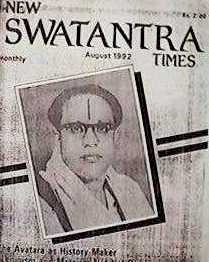
The Article:
Page 1
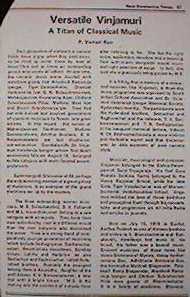
Page 2
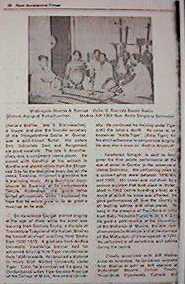
Page 3
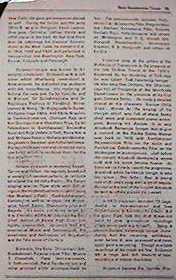
Page 4
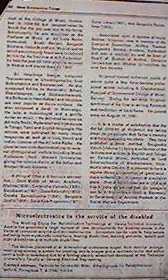
Versatile Vinjamuri
A Titan of Classical Music
By P. Vaman Rao
Each generation of stalwarts in various fields leave a gap when they pass away, to be filled up some times by men of lesser fiber and at times an outstanding genius who excels all others. At one time, the carnatic music scene dazzled with matchless giants like Ariyakudi Ramanuja Iyengar, Tiger Varadachariar, Chembai Vaidyanatha Bhagavatar, G. N. Balasubrahmanyam, Maharajapuram Viswanatha Iyer, Chittoor Subrahmanyam Pillai, Madurai Mani Iyer and Musiri Subarhmanya Iyer. They had not only trained but also inspired generations of classical musicians to flower into great artistes. In this regard, the names of Maharajapuram Santhanam, Madurai Somasundaram, Allathur Brothers, K.V. Narayanaswami are but illustrative not exhaustive. Ganakalanidhi Dr. Vinjamuri Varadaraja Iyengar, whose first death anniversary falls on August 16, belonged to this category with multi-faceted accomplishments.
Semmangudi Srinivasier at 84, perhaps, the only surviving member of a great galaxy of musicians, is an exemplar of the grand traditions set up by the masters.
The three outstanding women musicians, M. S. Subbulakshmi, D. K. Pattammal and M. L. Vasanthakumari belong to a rare category with no equals. They have their own individuality, cast in a different mould than the men stalwarts who dominated the scene. There is a strong band of comparatively younger generation of musicians, which include Seshagopalan, Sankaranarayanan, Neyattinkara Vasudevan, Bombay sisters, Lalitha and Haripriya as also Seshachari and Raghavachari, called Hyderabad brothers. Probably the youngest among them is Anuradha, the daughter of the well-known K. V. Narayanaswami, a new star with a bright future. "M. S. in the making" was the comment of a music-lover after listening to her. She has the right voice, application, devotion and a beaming face with charm along with sound music and right selection of songs. In fact, she said graciously, she is being guided by M. S.
It is fitting that in memory of a renowned musician like Vinjamuri, a three-day music programme was organized by South Indian Cultural Association and Dr. Vinjamuri Varadaraja Iyengar Memorial Society, Hyderabad, recently. The participants were Hyderabad Brothers, Seshachari and Raghavachari, T. N. Seshagopalan. In his inaugural memorial lecture, Vidwan N. Ch. Krishnamacharyulu, a Voco-Violinist and Harikatha expert said that Vinjamuri was an able exponent of pure carnatic style.
Musician, Musicologist and Composer, Vinjamuri belonged to the sishya parampara of Saint Thyagaraja. His first Guru, Piratla Sankara Sastry, belonged to the Veena Kuppier School while his later Guru; Tiger Varadachariar was of Manambuchavidi Venkatasubbaier School. Vinjamuri imbibed the best of those traditions and propagated them through his concerts, talks and programmes on All India Radio and articles in journals.
Born on July 15, 1915 in Guntur, Andhra Pradesh, as one of the thirteen brothers and sisters to V. Bhavanachariar and Kanakavalli, Varadaraja Iyengar had music in his blood. His father was a lover of music. Eminent musicians of those times like Veena Seshanna of Mysore, Veena Venkataramana Das, Adibhatla Narayana Das, Harikesanallur Muthaiah Bhagavatar, Palkkad Rama Bhagavatar, Ariyakudi Ramanuja Iyengar and Chittoor Subrahmanyam Pillai were guests of Bhavanachariar. It is a family of musicians. Varadaraja Iyengar's brother, late V. Srinivasachari, was a lawyer and also the founder-secretary of the Thyagabrahma Sabha in Guntur, was a well-known flutist. His sisters, Smt. Shakuntala and Ragamani are good vocalists. The late V. Ananthachary was a competent Veena player. He stayed with Gandhiji at his ashram in Wardha and played verses from the Bhagavat Gita for the Mahatma every day on the Veena. Swaroop, Vinjamuri's grand son, too is practicing music. At a devotional music session by Swaroop at Sri Venkateswara Temple, Hyderabad, the grandfather smiled affirmatively when I expressed the hope that he would grow to be as great a musician as he was.
Sri Varadaraja Iyengar started singing at the age of three while his sister was learning from Sankara Sastry, a disciple of Tiruvattiyur Tyagaier of Muthialpet. He himself received coaching from Sastry from 1920 - 1933. A graduate from Andhra University, Varadaraja Iyengar had his advanced training from Tiger Varadachariar from 1934 onwards. He obtained a Diploma in music from Madras University under Tiger. Later, he accompanied his guru to Chidambaram when Tiger became the principal of the College of Music, Annamalai University. He continued his training under Tiger until the latter's death. He came to be known as "Kutty Tiger" (Baby Tiger) for his strict adherence to Sampradaya singing. He was also known as "Andhra Ariyakudi".
Varadaraja Iyengar is said to have given his first public performance at the age of seven in Guntur in the presence of Veena Seshanna. His performing years as a concert artist were between 1930 and 1965. His carrier was cut short by a serious accident that took place in Hyderabad in 1962 (while boarding a bus) as a result of which his voice was affected. He gave performances all over the country in all leading Sabhas and other places. He sang in the presence of Presidents of India from Babu Rajendra Prasad to V. V. Giri. He gave a performance at the coronation of the Maharaja of Mysore, the late Jaya Chamarajendra Wodeyar and at the marriage of the Maharaja of Vizianagaram in 1943. He performed in all Samsthanams and Sabhas during the period.
Closely associated with AIR Madras since its inception, he broadcast concerts from Madras as well as AIR stations at Hyderabad, Mysore, Calicut, Trichi, Trivandrum, Vijayawada, Cuttack and New Delhi. He gave performances abroad as well. During the forties and the early fifties, he sang in Rangoon, Kaulalampur, Singapore, Colombo, Jafna, Candy and other places in the east. At that time, there was no patronage for classical Carnatic music in the west. Later, he visited U. S. A in 1964, 1984 and 1986 and performed in various cities like Washington, New York, Denver and Pittsburgh.
Vinjamuri Iyengar was known for his weighty classicism. Endowed with a rich voice, which effortlessly meandered in three octaves, he enthralled the audience with his manodharma. His rendering of Koluvai Unnade and Yarike Yarundu in Bhairavi, Sri Subrahmanyaya Namasthe and Sriraghuvara Prameya in Kambhoji, Brovavamma in Manji, Sri Rajagopala in Saveri, Akshaya Linga Vibho and Eduta Nilachithe in Sankarabharanam, Chakkani Raja and Kori Sevimparare in Kharahara Priya, Darini Telusukonti in Suddha Saveri, Emijesithe Nemi and Raju Vedala in Thodi, Rama Ninne and Mohana Rama in Mohana and Mokshamu Galada in Saramathi were full of brilliance. His repertoire was vast and contained many rare kritis, which he rendered them for the first time.
He was an expert in rendering Ragam, Tanam and Pallavi. He regularly broadcast a variety of ancient Pallavis in intricate Talas over the All India Radio. His Tanam singing was in Tiger's style, full of vigour. He rendered Pallavis in Rakthi ragas like Bhairavi, Thodi, Sankarabharanam, Kambhoji as well as in ragas like Bhavapriya, Varali, Saveri, Shanmukha Priya and Begada. His music Cutcheries lasted for 4 to 5 hours. As Sri M. Jagannatha Rao rightly commented, Vinjamuri had the emotion of Musiri and Semmangudi, the steadiness and techniques of Ariyakudi and the tala sense of Chittoor.
Stalwarts, like Karur Chinnaswamy Iyer, Kumbakkonam Rajamanikyam Pillai, Mysore T. Choudiah, Papa Venkatarama Iyer and others provided Violin accompaniment to him. The percussionists included Pudukkotai Dakshinamurthy Pillai, Phalghat Mani Iyer, Pazhani Subramania Pillai, Kolanka Venkataraju, Yella Somanna and others on the Mridangam and T. S. Bilvadri Iyer, Alangudi Ramachandran, Annavarapu Gopalam, K. S. Manjunathan and others on Kanjira.
Vinjamuri sang at the palace of the Maharaja of Travancore in the presence of the late Chitra Tirunal in the 1930s. Impressed by his rendering of the Todi raga he was called 'Todi Varadaraja Iyengar'. He also sang Nee Chittamu, the Dhanyasi raga kriti of Thyagaraja at the Muthyala Samsthanam in the presence of his first guru Sankara Sasrty. He made a detailed Neraval at the charanam "Guruve Chilla Ginja". Moved by the singing of his disciple, which was full of bhava, Sastry shed tears and composed poems extempore, blessing his disciple. It is said that Ariyakudi Ramanuja Iyengar was to give a concert at the Rasikaranjani Sabha, Madras, way back in 1935 with Kumbakkonam Rajamanikyam Pillai on the Violin and Pudukkotai Dakshinamurthy Pillai on the Mridangam as accompanists. Just before the concert, Ariyakudi developed a severe cold and his voice was hoarse. As there was no time to cancel the program, Ariyakudi asked Varadaraja Iyengar to take his place. The latter, then a young man of 20 years, sang with a lot of trepidation but at the end of the concert Ariyakudi as well as the others praised his concert.
In 1939, Vinjamuri recorded 'O Jagadamba' in Anandabhairavi and 'Sree Subrahmanyaya' in Kambhoji for Odeon. But, his guru, Tiger, told him that it was not good to give gramophone recordings (Tiger never gave any himself). Being a devout disciple, Varadaraja Iyengar immediately had the recordings withdrawn, even before it was processed and never again gave a recording. Though available recordings of his music are few, Vinjamuri left a large and rich treasure of tape recordings of master musicians.
Vinjamuri became the founder-principal of the college of music, Hyderabad in 1952 - 1953 but resigned when he found the job was not to his liking. Subsequently, he was appointed as the producer of music at All India Radio, Hyderabad. Bhakthi Ranjani, Sangeetha Sikshana, Vadya Brindam, Musical Operas, which are commonly heard, were introduced by him for the first time at AIR-Hyderabad. He held the post till 1964 when he returned to Madras and stayed there till 1988.
Sri Varadaraja Iyengar composed Thana Varnams in Ghanaraga Malika, Sinduramakriya and Swararanjani. He also composed krithis in Hemavathi, Bhilahari, Karaharapriya and Sankarabharanam. His Tillanas in Hamirkalyani and Hindolum are very popular as dance numbers. He also composed a javali in Manirangu. He was a musicologist and a prolific writer on music. He delivered lectures on All India Radio, Hyderabad and Vijayawada in Telugu, Tamil and English languages. His articles were published by many music magazines as well as Vani, Vanoli and Indian listener of the All India Radio. He gave lecture-cum-demonstrations to several distinguishes visitors including music professors from Western Universities giving the relative merits of the Indian and Western Music systems.
A string of titles and honours adorned him: Gold Medal of Music Academy, Madras (1936), Ganavidhya Visharada (1938), Gayakaratna (1941), Ganakalanidhi (1950), Gayaka Sarvabhouma (1956), Sangeetha Jyothi (1962), Ganakala Prapoorna (1971), Gana Lahari (1981) and Sangeetha Ratnakara (1982).
Associated with a number of music Sabhas, Vinjamuri was a member of the Executive Committee, Andhra Pradesh Sangeetha Nataka Academy, Hyderabad and also a member as well as Dean of Board of studies of Andhra, Osmania and Madras Universities for over two decades.
Vinjamuri trained numerous pupils of whom quite a few have become professional artists including K. Chandramouli, Principal of Government College of Music, Kurnool. During his last days, Vinjamuri spent most of his time in writing Ramakoti and meditation of Lord Rama. He passed away on August 16, 1991.
It is a matter of satisfaction that the dutiful children of Vinjamuri are taking steps to perpetuate their father's memory and for propagating his ideals. They have published a book entitled 'Sangeetha Vahini' (Volume 1) being a collection of the lectures and articles in English and Telugu on Carnatic Music, dedicated to Lord Ramachandra of Badrachalam, Vinjamuri's Ista Devata. It is planned to have a regular library of cassettes of great musicians collected by Vinjamuri at a suitable place. Five of his children are in USA and five in India, all well settled. Sri Iyengar's son, Sri V. Govindarajan, IAS, is Secretary to Government of Andhra Pradesh in the Social Welfare Department.